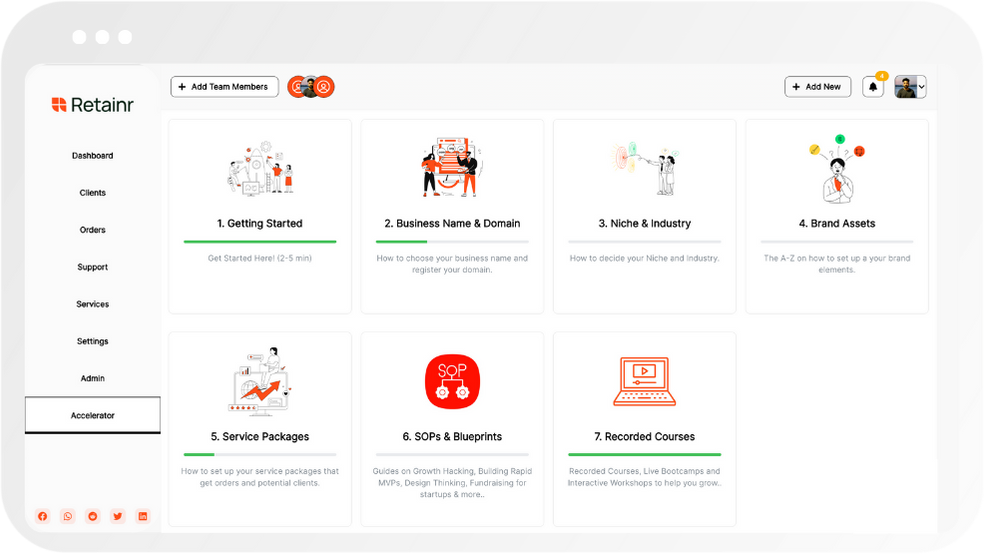
10 Top Tips for Creating an Effective Workflow Model
Build with Retainr
Sell your products and services, manage clients, orders, payments, automate your client onboarding and management with your own branded web application.
Get Started1. What are the top ten tips for creating an effective workflow model?
Understanding The Basics of Workflow Models
When designing a workflow model, understanding a few key principles can make all the difference. First, map your process clearly. The workflow should start from initiation to completion with a defined set of steps. Second, be sure to develop flexible processes and maintain effective communication throughout the process. Lastly, create an easy-to-understand and visually compelling workflow. Use symbols and colors that are easily understandable to help your staff interpret the workflow.
Tips for Creating an Effective Workflow Model
For a more detailed guide, consider the following ten tips:
- Identify all the tasks that need to be completed.
- Determine the order in which these tasks should be executed. Remember, some tasks will be dependent on others.
- Assign responsibility for each task to a specific person or team.
- Ensure all tasks are clearly defined so everyone knows what is expected.
- Optimize the workflow for efficiency. Avoid unnecessary steps or redundancies.
- Make sure the workflow is flexible enough to handle exceptions and unforeseen circumstances.
- Test the workflow before it is fully implemented. This will help you spot any potential issues or bottlenecks.
- Use a proven workflow management tool to aid in design and execution.
- Train your team thoroughly on the workflow and any associated tools or software.
- Regularly review and update the workflow to ensure it remains effective and efficient.
Designing a Workflow Model: Step by Step
| Step | Description |
|---|---|
| 1. Identify Tasks | Define every task necessary for the workflow. These should be specific, manageable tasks. |
| 2. Determine Order | Establish the most efficient order for executing tasks, taking into account task dependencies. |
| 3. Assign Responsibility | Assign each task to a specific person or team who will be responsible for its execution. |
| 4. Define Tasks | Ensure that each task is clearly defined so everyone understands what needs to be done. |
| 5. Optimize Workflow | Eliminate unnecessary steps and ensure the workflow is as efficient as possible. |
2. Why is it important to define clear objectives in creating an effective workflow model?
The Importance of Defining Clear Objectives
The primary step in creating an effective workflow model is defining clear, concise, and reachable targets. Properly defined objectives offer a robust structure and a purpose for each stage of the process. They assist in keeping everyone involved in the project on the same page, decreasing misunderstandings and conflicts. Furthermore, they enable measurability, facilitating easy progress tracking, and evaluation.
- Alignment: Defined objectives ensure all team members are working towards the same goal, reducing miscommunication.
- Focus: Clear goals provide a guideline for what needs to be achieved, enabling team members to focus on essential tasks.
- Measurability: Goals provide a benchmark against which progress can be measured, allowing for performance assessments at regular intervals.
Components of a Well-Defined Objective
A well-defined objective must be Specific, Measurable, Achievable, Relevant, and Time-bound (SMART). It provides a clear path and timeline towards achieving the goal. These components also aid in identifying when the goal has been achieved. A visual representation of this concept can be seen in the below table:
| Component | Description |
|---|---|
| Specific | The objective should clearly state what is to be achieved, by whom, where, and why. |
| Measurable | The objective should include concrete criteria for tracking progress and determining when the goal is achieved. |
| Achievable | The objective should be realistic, considering available resources. |
| Relevant | The objective should align with the team's broader goals and the company's strategic direction. |
| Time-bound | The objective should specify the time period within which it should be achieved to maintain focus and urgency. |
3. How do visual elements help in creating an effective workflow model?
Integration of Visual Elements in Workflow Models
Visual elements play a critical role in making workflow models more impactful, user-centric, and easy to understand. These elements, which include flow diagrams, color codes, symbols, and charts, facilitate comprehension and simplify complex processes. They help reduce the serious cognitive load that a text-heavy model might pose.
The Impact of Visual Elements on Workflow Models
- Increased Clarity: Visual elements allow for a clear and concise representation of processes and actions. A workflow model filled with text can be tough to follow, but using diagrams or flowcharts can delineate tasks and act as a roadmap for a project. For example, using lines to connect different tasks can show the relationship between them, making the sequence of actions easier to understand.
- Improved Communication: Visuals convey information quickly and are universally understood. Therefore, they help in bridging the communication gap between teams, allowing for a shared understanding on project expectations, roles, and tasks. This makes it easier to identify which stages of the project have been assigned to whom.
- Error Minimization: When processes are visually represented, it becomes easier to spot bottlenecks, inefficiencies, or potential errors. These can thus be addressed early, improving the overall efficacy of the model.
Implementing Visual Elements in Workflow Models
| Visual Element | Usage |
|---|---|
| Flowcharts | Used to illustrate the step-by-step progression of a task or process. |
| Color codes | Used to differentiate between different phases, tasks, roles or statuses within a workflow. |
| Symbols | Used to present different types of actions or decisions in a process. For example, an oval could represent the start or end point, a rectangle a processing step, and a diamond a decision point. |
| Charts | Used to present statistics related to workflow such as completion times or performance metrics. |
4. Can you explain the importance of testing and refining the workflow model?
The Importance of Testing and Refining the Workflow Model
Testing and refining the workflow model is a crucial part of the designing process. Initially, testing helps to ensure that the model works as expected, there are no mistakes or bugs, it aligns with business requirements, and most importantly, it brings efficiency and productivity in the desired tasks. Beside these, refining or improving the model based on testing results makes it more robust, streamlined and efficient.
- Ensure Correctness: Testing assures the correct functioning of the model by checking each function and process within the workflow. It helps in identifying mistakes or errors that could be overlooked during designing.
- Identify Improvement Areas: Testing can bring to light areas of your model that could be improved or streamlined. Refining these areas will lead to a more efficient workflow that can better accomplish its objectives.
- Align With Requirements: Testing and refining ensure the model aligns with the business needs and requirements which can change over time. This makes your workflow flexible and adaptable for future needs.
Table Illustrating Importance of Testing & Refining Workflow Models
| Importance | Description |
|---|---|
| Verification of model effectiveness | Testing validates the effectiveness of the model, double-checking to fulfill its purpose, it executes tasks efficiently and is properly aligned with business objectives. |
| Detection of errors and bugs | By means of thorough testing, any errors, bugs or shortcomings of the workflow model can be identified early, preventing any potential failures or malfunctions down the line. |
| Metrics for tweaks and improvements | Through testing and refining, performance metrics can be developed which can be used to tweak and improve the workflow model, ensuring optimum performance and efficiency. |
5. Why is assigning clear responsibilities an important tip for creating an effective workflow model?
The Significance of Assigning Clear Responsibilities
Assigning clear responsibilities is one of the critical tips for creating an effective workflow model. This aspect ensures that everyone involved in the process understands their roles and what is expected from them. The certainty it provides reduces confusion and potential errors that arise from uncertainties.
- Enhances accountability: When tasks are distinctly assigned, every team member knows their specific role and what results they're accountable for. This brings a system of responsibility that encourages each individual to deliver their best in their designated area.
- Promotes efficiency: It ensures that tasks are completed in a timely and efficient manner. When everyone knows their roles, work can be done concurrently, and there's less time wasted on figuring out who is supposed to do what. It also eliminates overlapping of tasks.
- Boosts morale: Clear assignment of duties fosters trust among team members. It shows management’s confidence in each member's abilities and builds their self-esteem. This can result in a more enthusiastic workforce and better productivity.
Importance of Clear Responsibilities in a Workflow Model: Illustrated in a Table
| Benefits | Explanation |
|---|---|
| Enhances Accountability | Tasks are given to specific people or teams, thereby establishing a sense of ownership and motivating them to perform their best. |
| Promotes Efficiency | By knowing exactly what their tasks are, team members can focus on completing their roles without confusion or delay, improving the overall workflow speed. |
| Boosts Morale | Clear role assignment shows trust in the abilities of team members, leading to increased confidence and improved team spirit. |
6. How do I start with the simplest process when creating a workflow model?
Understanding the Simplest Process
To begin with the simplest process when creating a workflow model, one has to first identify the simplest task within the process flow. These tasks are usually routine in nature, simple in execution, and require minimal resources. They also lack complexity and do not generally entail multiple decision points, approvals, or other such interventions. A simple process could be something as trivial as a single step approval or a document check. Identifying such simple tasks is the first step towards developing an effective workflow model.
Steps to Start with the Simplest Process
- Define the workflow's goal: First off, be clear about the specific result you want the workflow to achieve.
- Spell out tasks: List out all the tasks required to reach the goal - from start to finish.
- Identify simple tasks: Look for items in the list that are simple - they need few resources, little time, or simple actions.
- Order the tasks: Organize these tasks in the sequence in which they need to occur.
- Assign and document: Assign each task to team members and document the procedure in your workflow management system.
Sample Table to Prioritise Simple Processes
You can use a simple table to prioritise and organise simple tasks to start with your workflow model. Below is an example:
| Task | Priority | Assigned To |
|---|---|---|
| Single Step Approval | High | Manager |
| Document Check | Medium | Document Controller |
In summary, always start with the simplest process, prioritize and categorize them according to their influence on the overall result, and ensure they're assigned to appropriate personnel.
7. What is the role of communication in developing an effective workflow model?
Role of Communication in Workflow Model Development
Proper communication plays a pivotal role in the development of an effective workflow model. It is the glue that holds all the aspects of a workflow together, promoting a better understanding of objectives, streamlining processes, and ensuring that everyone is on the same page.
- Clarification of Roles: Clear communication sets up the structure of the workflow. It is how tasks are delegated, responsibilities are assigned, and roles are clarified. Everyone within the team must understand who is doing what, who needs what, and who is accountable for each task. Without this clarity, there might be unnecessary repetition of tasks or even worse, crucial tasks may be overlooked.
- Informed Decision Making: Communication provides the necessary information for informed decision-making. It is the process that ensures the right data reaches the right people at the right time. This can include updates about progress, changes in the environment, challenges faced, and so on.
- Optimization: Finally, communication allows for optimization. It allows team members to share feedback, suggest improvements or adjustments, and allows teams to adapt to changes in real time. It ensures that the workflow model remains agile and effective.
| Aspect | Role of Communication |
|---|---|
| Clarification of Roles | Ensures task delegation and accountability |
| Informed Decision Making | Delivers necessary information at the right time |
| Optimization | Allows for feedback and adjustments |
In conclusion, effective communication is crucial in the development and maintenance of an effective workflow model. It clarifies roles, facilitates informed decision making, and promotes optimization – resulting in a more efficient and productive work environment.
8. What is meant by 'adapting the workflow to the team's needs' in context of creating an effective workflow model?
Understanding 'Adapting the Workflow to the Team's Needs'
The concept of 'adapting the workflow to the team's needs' implies modifying and rearranging the sequence of operations or processes to align with the requirements and capabilities of the team. A workflow should be flexible and accessible enough to change whenever necessary to optimize the team's productivity and efficiency.
Benefits of Adapting the Workflow to the Team's Needs
- Efficiency: A tailored workflow decreases the risk of pitfalls or problems that could slow down the team. Unnecessary procedures are eliminated, and team members can focus better on their respective tasks which leads to greater efficiency.
- Clarity: Customizing the workflow as per the team's needs serves to provide clarity to the team members. Everyone understands their roles and responsibilities, reducing ambiguities and improving performance.
- Improved Team Morale: When the workflow is attuned to the team's strengths and weaknesses, it can increase job satisfaction, leading to improved team morale, higher motivation, and increased productivity.
Example of Adapting Workflow to the Team's Needs
| Action | Before Adaptation | After Adaptation |
|---|---|---|
| Task Assignment | Tasks are assigned randomly to the team members | Tasks are assigned based on individual team member’s expertise and preferences |
| Communication | Updates and feedback are given during weekly meetings | Updates and feedback are given immediately through real-time communication tools |
| Workflow Process | One standard process for every task irrespective of its nature | Different processes adapted for different tasks recognizing the unique requirements of each task |
9. Can you elaborate on how i can automate repetitive tasks in a workflow model?
Understanding Automation in Workflows
Automation is a powerful tool in workflow modeling, significantly improving efficiency by reducing the time spent on repetitive tasks. It involves using systems or applications to automatically manage, control and process specific tasks in a workflow. In implementing automation, tasks such as data entry, notifications, approvals and reporting can be set to run automatically under specific conditions.
Steps to Automate Repetitive Tasks
- Identify the repetitive tasks: It is crucial to determine which responsibilities are performed frequently and could be automated. These jobs are usually time-consuming and are prone to human error.
- Choose the right software: A wide range of workflow automation tools are available. Select one that can accommodate your process complexity and provide the necessary customization options.
- Set up the automation rules: Define the conditions under which tasks should be automatically executed, based on the specific trigger points.
- Test the automated workflow: Always test new automated workflows to ensure they are working correctly, and to prevent potential disruptions to your process.
- Continual monitoring and adjustments: Regularly review the system performance and adjust as necessary.
Benefits of Automating Repetitive Tasks
| Benefit | Description |
|---|---|
| Efficiency | Automation frees up time which in turns increases productivity. |
| Accuracy | Automated tasks are less susceptible to human error, improving data accuracy. |
| Consistency | Automation ensures uniform completion of tasks which maintains process consistency. |
| Cost Savings | The reduction in time and manual labor can result in significant cost savings. |
10. Why is regular reviewing and updating considered a top tip for creating an effective workflow model?
Importance of Regular Reviewing and Updating in a Workflow Model
Just as in numerous sectors, the world of business sees constant change and evolution. Regular reviews and updates are integral to adapt to these changes and maintain an effective workflow model. It involves continuous monitoring and improvement of the model to ensure that it is still relevant and effective. This practice is considered a top tip because of the various significant benefits it offers.
- Optimization: Frequent reviewing helps in identifying redundancies and inefficiencies in the system. Modification based on this evaluation caters to process optimization and enhancement of overall productivity.
- Problem-solving: Workflow models often encounter obstacles and issues. Regular examination and timely resolution of these issues maintain the smooth functioning of the model.
- Adaptation: Constant review helps in identifying the need for change and adapt the model according to the latest developments and trends, ensuring that the system stays current and efficient.
The Process of Reviewing and Updating
The process of regular reviewing and updating comprises several steps. Here is a basic outline:
| Steps | Description |
|---|---|
| Step 1: Review | Check the current workflow model; examine each process and understand its effectiveness. |
| Step 2: Identify | Identify the redundancies, inefficiencies, and obstacles in the system. |
| Step 3: Strategize | Formulate strategies to address the identified issues. |
| Step 4: Implement | Implement the changes and solutions based on the strategies formulated. |
| Step 5: Monitor | Monitor the newly applied changes and measure their effectiveness. |
Conclusion
In a rapidly changing business environment, an effective workflow model is crucial for the smooth functioning of a business. Regular reviewing and updating make sure that the workflow stays appropriate and efficient according to current circumstances. Thus, it is rightly considered a top tip in creating an effective workflow model.
Conclusion
Creating an Effective Workflow Model
Efficient workflow models are critical for business success. With the right model, you can automate tasks, streamline processes, and increase productivity. This blog provides ten top tips to create a supreme workflow model. These tips revolve around thoroughly understanding your processes, defining clear objectives, analyzing your workflow's feasibility, effectively communicating the devised plan, using the right tools, regularly reviewing and updating your workflow, and more. Ensuring these elements can result in a workflow model that can improve the efficiency of your overall business processes significantly.
Optimize your Workflow Model with Retainr.io
The right tools are essential for an effective workflow model, and that's where Retainr.io comes into play. This whitelabel software is an all-in-one platform designed specifically to sell, manage clients, orders, and payments seamlessly. Retainr.io allows you to streamline your processes with its various features, making it a valuable asset in any workflow model. From simplifying client management to secure payment processing, Retainr.io can tackle it all.
Click here to start using Retainr.io to take your workflow model to the next level. This software adapts to your specific business needs, providing a customized solution that boosts your operational efficiency while saving you time and resources. Implementing Retainr.io into your workflow will not only improve business operations but will also elevate customer experience- a win-win for any business.
Conclusion
An effective workflow model is the backbone of a thriving business operation. With the right processes and the appropriate tools like Retainr.io, you can streamline operations and enhance efficiency, pushing your business closer to its objectives.
Boost Your Agency Growth
with Retainr Accelerator
Uncover secrets, strategies, and exclusive blueprints to take your agency's growth to the next level — from marketing insights to effective presentations and leveraging technology.

SOPs, Cheatsheets & Blueprints
Leverage 50+ SOPs (valued over $10K) offering practical guides, scripts, tools, hacks, templates, and cheat sheets to fast-track your startup's growth.
Connect with fellow entrepreneurs, share experiences, and get expert insights within our exclusive Facebook community.
.jpg)

Join a thriving community of growth hackers. Network, collaborate, and learn from like-minded entrepreneurs on a lifelong journey to success.

Gain expertise with recorded Courses, Live Bootcamps and interactive Workshops on topics like growth hacking, copywriting, no-code funnel building, performance marketing and more, taught by seasoned coaches & industry experts.

.jpg)

.jpeg)


